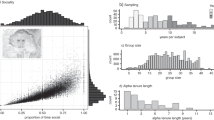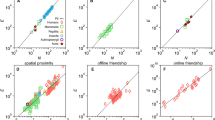Summary
We tested the hypothesis that populations composed of unrelated animals should perform worse than those composed of related animals by setting up two moderatedly dense field populations in adjacent enclosures: one was composed of related females and one of unrelated females; both had unrelated males. The survival and reproductive success of a number of litters located by spooling were determined. Final population size, pregnancy success, number of young recruited per pregnancy, and survival were similar in both populations. Thus, differences in relatedness produced no differences in demography. We conclude that the Charnov-Finerty Hypothesis in unlikely to be an explanation for microtine population fluctuations.
Similar content being viewed by others
References
Baird DD, Birney EC (1982) Pattern of colonization in Microtus pennsylvanicus. J Mammal 63:290–293
Bekoff M (1981) Vole population cycles: kin-selection or familiarity? Oecologia (Berlin) 48:131
Blaustein AR, Bekoff M, Daniels TJ (1987) Kin recognition in vertebrates (excluding primates) empirical evidence. In: Fletcher DJC, Michener CD (eds) Kin recognition in animals. Wiley, New York, pp 287–331
Boonstra R (1978) Effect of adult Townsend voles (Microtus townsendii) on survival of young. Ecology 59:242–248
Boonstra R, Boag PT (1987) A test of the Chitty Hypothesis: inheritance of life-history traits in meadow voles Microtus pennsylvanicus. Evolution 41:929–947
Boonstra R, Craine ITM (1986) Natal nest location and small mammal tracking with a spool-and-line technique. Can J Zool 64:1034–1036
Boonstra R, Rodd FH (1983) Regulation of breeding density of Microtus pennsylvanicus. J Anim Ecol 52:757–784
Boonstra R, Krebs CJ, Gaines MS, Johnson ML, Craine ITM (1987) Natal philopatry and breeding systems in voles (Microtus spp.). J Anim Ecol 56:655–673
Boyd SK, Blaustein AR (1985) Familiarity and inbreeding avoidance in the gray-tailed vole (Microtus canicaudus). J Mammal 66:348–352
Brown RZ (1953) Social behaviour, reproduction, and population changes in the house mouse (Mus musculus L.) Ecol Monogr 23:217–240
Caley J, Boutin S (1985) Infanticide in wild populations of Ondatra zibethicus and Microtus pennsylvanicus. Anim Behav 33:1036–1037
Caley MJ, Boutin S (1987) Sibling and neighbour recognition in wild juvenile muskrats. Anim Behav 35:60–66
Carothers AD (1973) Capture-recapture methods applied to a population with known parameters. J Anim Ecol 42:125–146
Charnov EL, Finerty JP (1980) Vole population cycles: a case for kin-selection. Oecologia (Berlin) 45:1–2
Clarke JR (1965) Influence of numbers on reproduction and survival in two experimental vole populations. Proc R Soc London Ser B 144:68–85
Craine ITM, Boonstra R (1986) Myiasis by Wohlfahrtia vigil in nestling Microtus pennsylvanicus. J Wildl Dis 22:587–589
Danielson BJ, Gaines MS (1987) The influence of conspecific and heterospecific residents on colonization. Ecology 68:1778–1784
De Kock LL, Rohn I (1972) Intra-specific behaviour during the upswing of groups of Norway lemmings, kept under semi-natural conditions. Z Tierpsychol 30:405–415
Gaines MS, Johnson ML (1987) Phenotypic and genotypic mechanisms for dispersal in Microtus populations and the role of dispersal in population regulation. Am Zool (in press)
Gavish L, Hoffman JE, Getz LL (1984) Sibling recognition in the prairie vole, Microtus ochrogaster. Anim Behav 32:362–366
Grau JH (1982) Kin recognition in white-footed deermice (Peromyscus leucopus. Anim Behav 30:497–505
Hamilton WD (1964) The genetical evolution of social behavior. I and II. J Theor Biol 7:1–52
Hamilton WJ (1941) Reproduction of the field mouse Microtus pennsylvanicus (Ord). Cornell Univ Agr Exp Stat Memoir 237:1–23
Holmes WG, Sherman PW (1982) The ontogeny of kin recognition in two species of ground squirrels. Am Zool 22:491–517
Johnson ML, Gaines MS (1987) The selective basis for dispersal of the prairie vole, Microtus ochrogaster. Ecology 68:684–694
Kawata M (1987) The effect of kinship on spacing among female red-backed voles, Clethrionomys rufocanus bedfordiae. Oecologia (Berlin) 72:115–122
Krebs CJ (1971) Genetic and behavioral studies on fluctuating vole populations. In: Den Boer PJ, Gradwell GR (eds) Dynamics of populations. Proceedings of the Advanced Study Institute on Dynamics of Numbers in Populations, Oosterbeek, Netherlands, pp 243–256
Krebs CJ (1985) Do changes in spacing behaviour drive population cycles in small mammals? In: Sibly RM, Smith RH (eds) Behavioural ecology: ecological consequences of adaptive behaviour, Symp 25. Br Ecol Soc, pp 295–312
Krebs CJ (1988) Are lemmings large Microtus or small reindeer? A review of lemming cycles after 25 years. Biol Journal Linn Soc (in press)
Krebs CJ, Boonstra R (1984) Trappability estimates for markrecapture data. Can J Zool 62:2440–2444
Krebs CJ, Myers JH (1974) Population cycles in small mammals. Adv Ecol Res 8:267–399
Krebs CJ, Keller BL, Tamarin RH (1969) Microtus population biology: demographic changes in fluctuating populations of M. ochrogaster and M. pennsylvanicus in southern Indiana. Ecology 50:587–607
Krebs CJ, Wingate I, LeDuc J, Redfield JA, Taitt M, Hilborn R (1976) Microtus population biology: dispersal in fluctuating populations of M. townsendii. Can J Zool 54:79–95
Lidicker WZ Jr (1985) Dispersal. In: Tamarin RH (ed) Biology of New World Microtus. Spec Publ Am Soc Mammal 8:420–454
Madison DM (1980) Space use and social structure in meadow voles, Microtus pennsylvanicus. Behav Ecol Sociobiol 7:65–71
McShea WJ, Madison DM (1984) Communal nesting between reproductively active females in a spring population of Microtus pennsylvanicus. Can J Zool 62:344–346
McShea WJ, Madison DM (1987) Partial mortality in nestling meadow voles, Microtus pennsylvanicus. Anim Behav 35:1253–1255
Redfield JA, Taitt MJ, Krebs CJ (1978) Experimental alteration of sex ratios in populations of Microtus townsendii, a field vole. Can J Zool 56:17–27
Rodd FH, Boonstra R (1988) Effects of adult meadow voles, Microtus pennsylvanicus on young conspecifics in field populations. J Anim Ecol 57:(in press)
Semb-Johansson A, Wiger R, Engh CE (1979) Dynamics of two freely growing confined populations of the Norwegian lemming Lemmus lemmus. Oikos 33:246–260
Stenseth NC (1983) Causes and consequences of dispersal in small mammals. In: Swingland IR, Greenwood PJ (eds) The Ecology of animal movement. Cambridge University Press, Oxford, pp 63–101
Taitt MJ, Krebs CJ (1985) Population dynamics and cycles. Spec Publ Am Soc Mammal 8:567–620
Tamarin RH, Sheridan M (1987) Behavior-genetic mechanisms of population regulation in microtine rodents. 27:921–927
Tamarin RH, Reich LM, Moyer CA (1984) Meadow vole cycles within fences. Can J Zool 62:1796–1804
Verner L, Getz LL (1985) Significance of dispersal in fluctuating populations of Microtus ochrogaster and M. pennsylvanicus. J Mammal 66:338–347
Warkowska-Dratnal H, Stenseth N (1985) Dispersal and the microtine cycle: Comparison of two hypotheses. Oecologia (Berlin) 65:468–477
Webster AB, Brooks RJ (1981) Social behavior of Microtus pennsylvanicus in relation to seasonal changes in demography. J Mammal 62:738–751
Author information
Authors and Affiliations
Rights and permissions
About this article
Cite this article
Boonstra, R., Hogg, I. Friends and strangers: a test of the Charnov-Finerty Hypothesis. Oecologia 77, 95–100 (1988). https://doi.org/10.1007/BF00380931
Received:
Issue Date:
DOI: https://doi.org/10.1007/BF00380931




